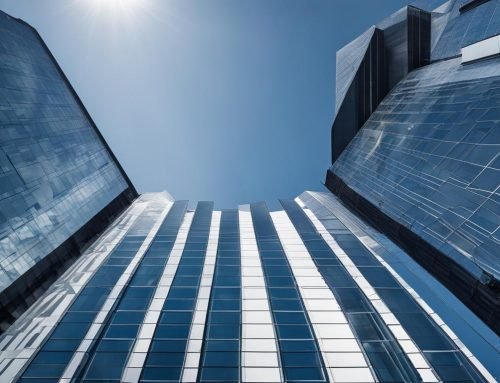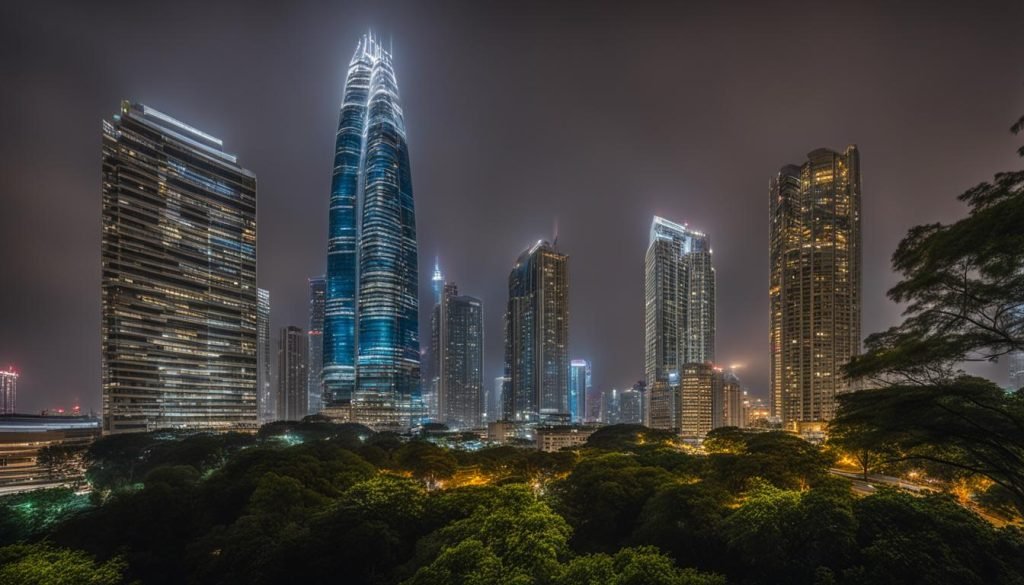
Architecture photography is a captivating art form that allows you to capture the beauty and intricacies of architectural structures. Whether you’re an aspiring architectural photographer or looking to improve your skills, this article will provide valuable tips and techniques to help you capture stunning images of buildings.
From choosing the right equipment to mastering composition, we will explore the world of architecture photography in the UK and beyond, enabling you to unleash your creativity and capture the essence of buildings.
Key Takeaways:
- Architecture photography is an art form that focuses on capturing the beauty and intricacies of architectural structures.
- Choosing the right equipment, such as a high-quality camera and wide-angle lenses, is crucial for capturing stunning architectural images.
- Mastering composition techniques, such as leading lines, symmetry, and the rule of thirds, can enhance the visual impact of your architectural photographs.
- Understanding lighting and how it affects the mood and appearance of a building is essential for creating compelling architectural images.
- Editing software, like Adobe Lightroom or Photoshop, can help enhance the colors and sharpness of your architectural photos while maintaining a natural look.
Understanding Architecture Photography
Architecture photography is a specialized genre that focuses on capturing buildings and structures in a visually appealing way. It requires specific equipment, such as a high-quality camera with wide-angle lenses and a tripod to ensure stability and avoid distortions. In addition, architectural photographers need to understand various techniques and principles to effectively convey the unique features and design elements of a building through their photographs.
In architecture photography, equipment plays a crucial role in capturing the intricacies of architectural structures. A high-quality camera with wide-angle lenses allows you to capture the entirety of a building, showcasing its grandeur and details. Investing in a sturdy tripod is essential to ensure stability, especially when shooting in low-light conditions or needing long exposures.
Moreover, architectural photographers should familiarize themselves with various techniques and principles to create captivating images. Understanding composition techniques like leading lines, symmetry, and framing helps bring balance and visual interest to your photographs. By applying these techniques, you can highlight the unique features and design elements of the buildings you photograph.
By combining the right equipment and mastering composition techniques, architectural photographers can create stunning images that capture the essence of a building. In the next section, we will explore the essential equipment needed for architecture photography in more detail.
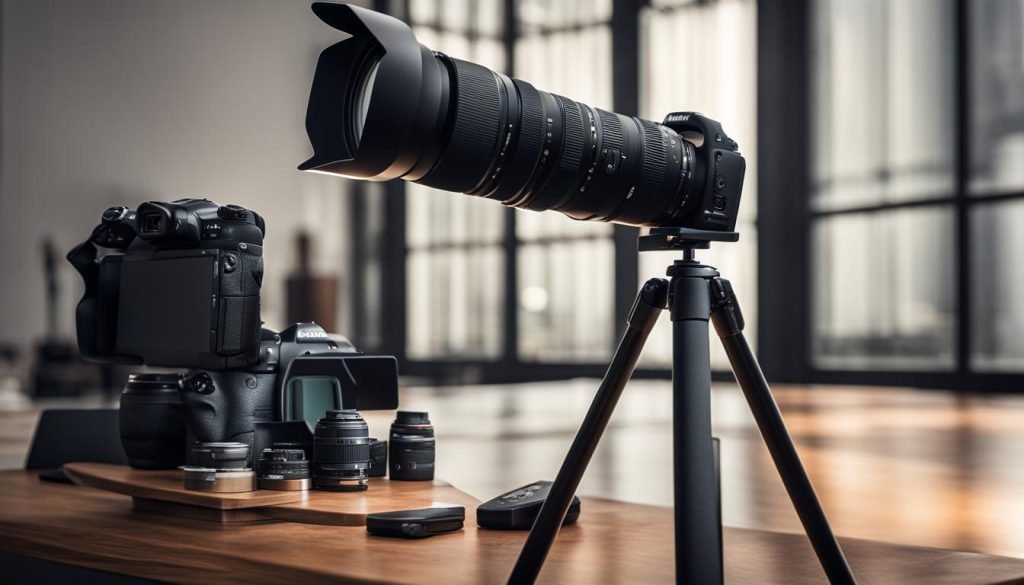
Essential Equipment for Architecture Photography
In order to capture stunning images of architectural structures, it is crucial to have the right equipment. Here are some essential tools that every architecture photographer should have in their kit:
- A high-quality DSLR camera: Invest in a camera with a high resolution and good low-light performance to capture the intricate details of buildings.
- Wide-angle lenses: Wide-angle lenses allow you to capture the entirety of a building and emphasize its scale and grandeur.
- Tripod: A sturdy tripod is essential for keeping your camera stable, especially when shooting in low light conditions or capturing long exposure shots.
- Remote shutter release: This allows you to take photos without touching the camera, minimizing any potential camera shake or blurriness.
- Lens hood: A lens hood helps to minimize lens flare and unwanted reflections, ensuring that your images are crisp and clear.
- Polarizing filter: A polarizing filter can be useful for controlling reflections and enhancing the overall colors and contrast in your architectural photographs.
By having these essential tools in your architectural photography kit, you’ll be well-equipped to capture the beauty and intricacies of buildings with precision and creativity.

Having the right equipment is paramount to achieve stunning architectural photographs. Invest in high-quality DSLR camera, wide-angle lenses, and a sturdy tripod to capture the grandeur of buildings. Additionally, a remote shutter release, lens hood, and polarizing filter can further enhance the quality and control of your images.
Composition Techniques in Architecture Photography
Mastering the Art of Framing
One of the key composition techniques in architecture photography is framing. By strategically placing elements within the frame, you can create a sense of depth and guide the viewer’s eye towards the main subject. Look for natural frames such as doorways, windows, or arches that can frame the building and add visual interest to your photograph. Experiment with different angles and perspectives to find the perfect frame that enhances the architectural structure.
Creating Balance with Symmetry
Symmetry is another powerful composition technique that can bring harmony and balance to your architectural photographs. Many buildings are inherently symmetrical, with matching elements on both sides. By centering the building and ensuring that the vertical and horizontal lines are parallel to the edges of the frame, you can create a sense of order and equilibrium. Symmetry can be particularly effective when photographing grand architectural structures like palaces or cathedrals.
Leading Lines for Visual Impact
Leading lines are another composition technique commonly used in architecture photography to create a sense of depth and guide the viewer’s gaze. Look for lines within the building or its surroundings, such as roads, pathways, or railings, that can lead the eye towards the main subject. By incorporating these lines into your composition, you can add visual interest and create a dynamic image that draws the viewer in.
Remember, composition is subjective, and there are no strict rules. Experiment with different techniques, angles, and perspectives to discover your own unique style and create stunning architecture photographs that capture the essence of the building.

Lighting in Architecture Photography
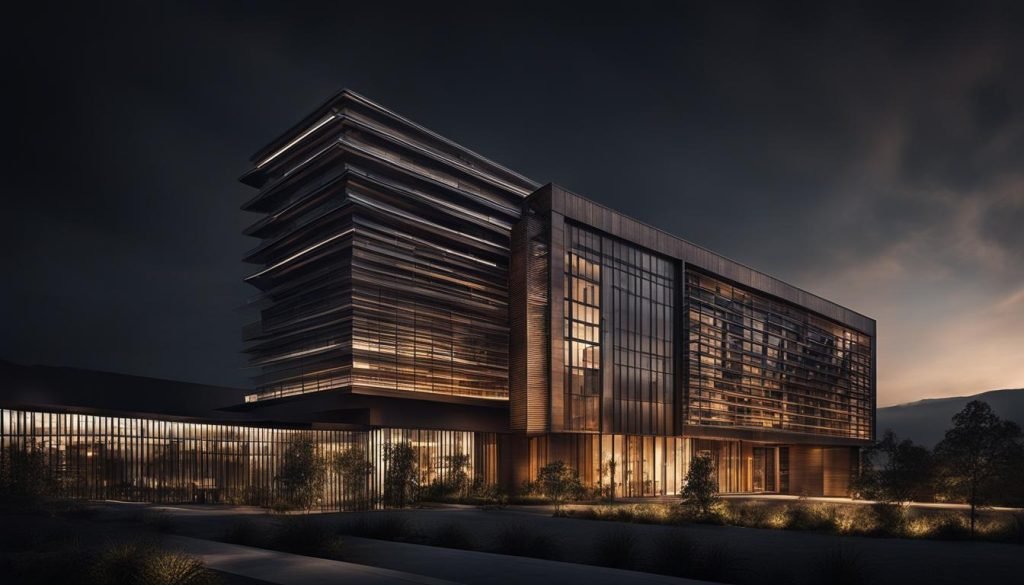
When it comes to architecture photography, lighting is one of the most important factors to consider. The way light interacts with buildings can dramatically affect the final result of your photographs. Understanding how to utilize different types of lighting and taking advantage of the right time of day can help you capture stunning architectural images.
One technique that photographers often employ is shooting during the golden hours, which occur shortly after sunrise or before sunset. During these times, the light is soft and warm, creating a beautiful ambiance that enhances the architectural features of the building. The long shadows cast by the low-angle light can add depth and dimension to your photos.
Additionally, shooting at night can provide a unique opportunity to capture the architectural beauty of a building in a different light. By using long exposures, you can capture the city lights as a stunning backdrop, creating a captivating juxtaposition between man-made structures and the natural beauty of the surrounding environment.
“Lighting is like paint to a photographer. It allows you to create depth, mood, and atmosphere in your architectural photographs.”
Experimenting with different lighting conditions and techniques is key to developing your own style as an architectural photographer. Play around with the angle and direction of light, and observe how it affects the textures and details of the building. Don’t be afraid to push the boundaries and try new things to capture the essence and character of the architecture.
Working with Natural and Artificial Lighting
Whether you’re shooting in natural or artificial light, understanding how to work with both can greatly enhance your architectural photography. Natural light can create a softer and more organic look, while artificial light can provide a more dramatic and controlled effect.
When shooting in natural light, pay attention to the direction and intensity of the sunlight. The angle of the sun can highlight certain architectural features and create interesting shadows, while the intensity can affect the overall mood of the image. Consider using reflectors or diffusers to manipulate the natural light and achieve the desired effect.
On the other hand, when shooting with artificial light sources such as studio strobes or off-camera flash, you have more control over the lighting conditions. This allows you to highlight specific areas of the building and create a more stylized and dramatic look. Experiment with different lighting setups and techniques to achieve the desired effect and evoke the intended emotions.
Editing Techniques for Architecture Photography
Editing is an essential part of the architecture photography process. With editing software like Adobe Lightroom or Photoshop, you can enhance the colors, contrast, and sharpness of your architectural photos. It’s important to maintain the natural look of the building while enhancing its features, creating a balanced and visually appealing image.
One important editing technique for architecture photography is perspective correction. This involves correcting any distortions caused by the camera lens and ensuring that the vertical lines of the building remain straight. This can be achieved using tools like the Transform or Lens Correction features in editing software.
Another crucial aspect of editing is adjusting the white balance. This allows you to correct any color casts caused by different lighting conditions. It’s important to ensure that the colors in your photo accurately represent the building’s true appearance. You can use the White Balance tool in your editing software to achieve this.
Removing distractions is also an important step in the editing process. This includes removing any objects or elements that may detract from the overall composition of the image. Use the Clone Stamp or Healing Brush tool to remove unwanted objects and create a clean and uncluttered photo.
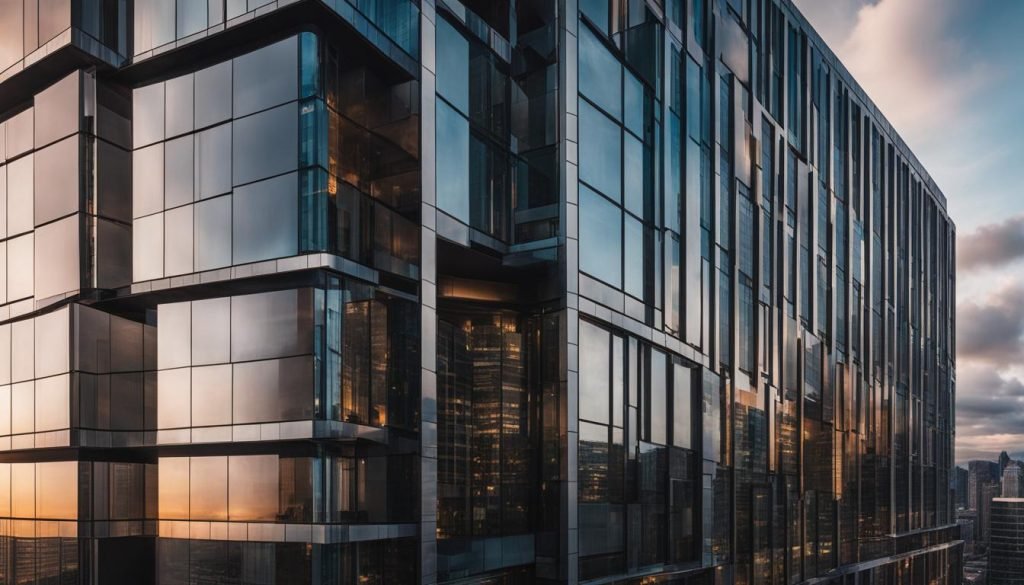
Creating a Cohesive Look
In addition to these basic editing techniques, you can also use various filters and presets to create a cohesive look for your architecture photography portfolio. Experiment with different styles and effects to develop your own unique aesthetic. This will help give your photos a consistent and professional appearance.
Remember, the goal of editing in architecture photography is to enhance the natural beauty of the building and create a visually stunning image that accurately represents the architect’s vision.
- Adjust colors and contrast
- Correct perspective and straighten vertical lines
- Remove distractions and clean up the image
- Experiment with filters and presets to create a cohesive look
Showcasing Your Architecture Photography Portfolio
Building a strong architecture photography portfolio is crucial for showcasing your skills and attracting potential clients or opportunities. Your portfolio is a visual representation of your unique style and ability to capture the essence of architectural structures. When curating your portfolio, select your best photographs that highlight your technical skills, creativity, and attention to detail. Look for images that demonstrate your ability to capture the beauty, scale, and unique features of different buildings.
Consider creating an online portfolio to showcase your work to a wider audience. Your online portfolio should be well-organized, visually appealing, and easy to navigate. Include a variety of architectural photographs that demonstrate your versatility and ability to capture different styles and periods of architecture. Add descriptive captions or explanations for each photograph to provide context and highlight your thought process.
In addition to your online portfolio, consider participating in photography exhibitions and competitions to gain exposure and recognition within the industry. Submitting your work to these platforms can help you gain feedback, connect with other photographers and industry professionals, and potentially secure new opportunities. Take advantage of social media platforms like Instagram to share your work, interact with potential clients, and build a network within the industry.
Creating a Memorable Portfolio
- Focus on quality over quantity: Include only your best work to make a strong impression.
- Showcase variety: Include photographs that demonstrate your ability to capture different architectural styles and subjects.
- Highlight your unique style: Develop a visual signature that sets you apart from other architectural photographers.
- Consider the presentation: Pay attention to the layout, design, and navigation of your online portfolio to create a seamless user experience.
- Keep your portfolio updated: Regularly update your portfolio with new and improved work to reflect your growth as a photographer.
By taking the time to curate a strong architecture photography portfolio, you can effectively showcase your skills and attract new opportunities in the field. Your portfolio will serve as a visual representation of your unique style and ability to capture the beauty and character of architectural structures. With a well-presented portfolio and a strong online presence, you can establish yourself as a reputable architectural photographer in the UK and beyond.
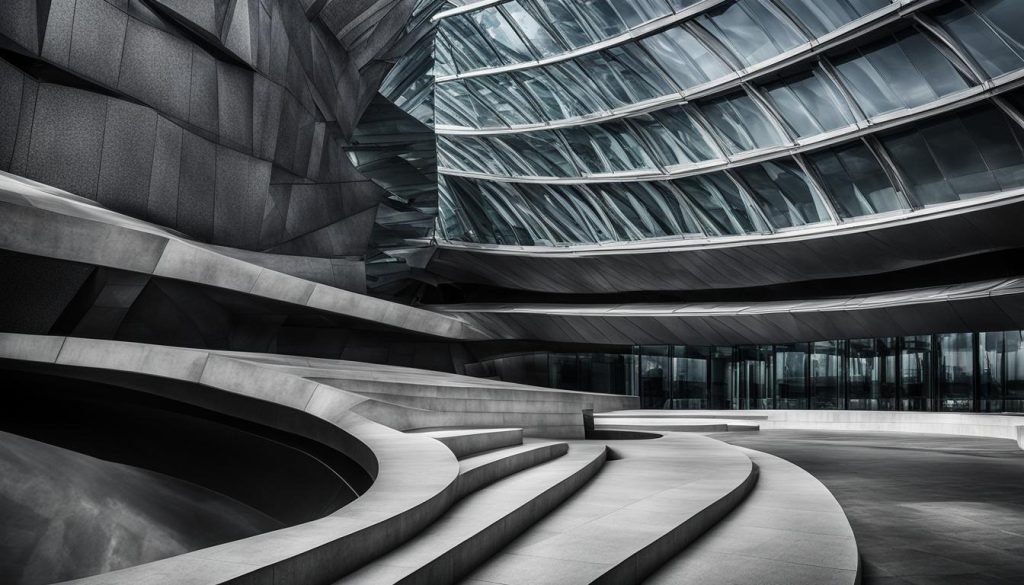
Exploring Architecture Photography in the UK
When it comes to architecture photography, the United Kingdom offers a treasure trove of picturesque buildings and structures waiting to be captured through the lens of your camera. From iconic landmarks like Buckingham Palace and Tower Bridge in London to modern architectural marvels like the Shard and the Eden Project, there is no shortage of subjects to photograph in the UK.
By exploring different cities and regions across the country, you can not only expand your architecture photography portfolio but also discover unique architectural gems that showcase the rich history and diverse architectural styles present in the UK. Whether you prefer capturing the grandeur of historic sites or the sleek lines of contemporary buildings, there is something for every architectural photographer in the UK.
“The UK is truly a photographer’s playground when it comes to architecture. The blend of old and new, traditional and modern, provides endless opportunities for capturing stunning images that tell a story,” says renowned architectural photographer, Emily Jenkins.
Consider taking architectural photography tours in cities like London, Bath, or Edinburgh, where expert guides can lead you to the best vantage points and hidden gems. These tours not only offer valuable insights into the history and significance of the structures but also provide the chance to connect with fellow photographers who share your passion for capturing the beauty of architecture.
Discovering Architectural Wonders in the UK
- London: Explore the iconic landmarks such as the Houses of Parliament, St. Paul’s Cathedral, and the Gherkin. Don’t forget to capture the vibrant London skyline from vantage points like Primrose Hill or the South Bank.
- Edinburgh: Wander through the charming streets of the Old Town, photographing historic buildings like the Edinburgh Castle and the Royal Mile. For a modern touch, head to the Scottish Parliament building or the dynamic architecture of the Scottish National Gallery of Modern Art.
- York: Immerse yourself in the medieval charm of York and capture the majestic York Minster, the city walls, and the intricate architecture of The Shambles.
- Bath: Visit the Roman Baths, marvel at the Georgian architecture of the Royal Crescent and the Circus, and explore the stunning Bath Abbey.
With its rich history, stunning landscapes, and diverse architecture, the UK provides a wealth of opportunities to capture the beauty and character of buildings through photography. So grab your camera, pack your lenses, and embark on an architectural adventure to document the wonders of the United Kingdom.

Getting Started with Architecture Photography: Tips for Beginners
Are you new to architecture photography? Don’t worry, we’ve got you covered! Here are some valuable tips to help you embark on your photography journey. First and foremost, take the time to study the work of renowned architectural photographers. By analyzing their compositions and lighting techniques, you can gain inspiration and a better understanding of how to capture the essence of architectural structures.
Next, don’t be afraid to experiment with different angles, perspectives, and focal lengths. Architecture photography is all about finding unique shots that showcase the beauty of the buildings. So, get creative and think outside the box!
Another important tip is to practice regularly. The more you practice, the more you’ll refine your skills and develop your own style. Take advantage of different weather conditions and lighting situations to add variety and depth to your portfolio. And don’t forget to make the most of the golden hours – the magical moments shortly after sunrise and before sunset when the light is soft and warm.
Remember these key tips:
- Study the work of renowned architectural photographers for inspiration.
- Experiment with different angles, perspectives, and focal lengths.
- Practice regularly and make use of different weather conditions.
- Take advantage of the golden hours for beautiful lighting.
Now that you have these tips in your arsenal, it’s time to grab your camera and start capturing the beauty of architectural structures. Remember, practice makes perfect, so keep exploring, learning, and improving your photography skills. Happy shooting!
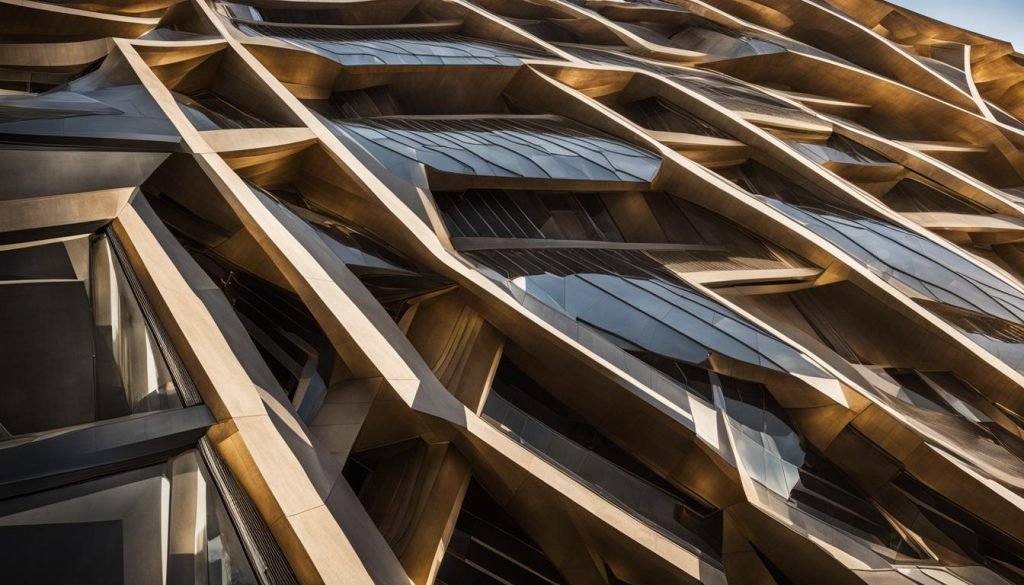
Enhancing Your Architecture Photography Skills
As an architectural photographer, continuously honing your skills is vital to stand out in a competitive field. There are various ways to enhance your architecture photography techniques and capture the essence of buildings with finesse.
One effective method is to attend workshops and join photography communities. These platforms provide opportunities to learn from industry experts, gain insights into the latest trends, and exchange ideas with fellow photographers. Engaging with other architectural photographers can offer valuable perspectives and open new doors for collaboration and inspiration.
Experimentation is another key aspect of skill enhancement. Try different styles and approaches to develop your own unique artistic vision. Push the boundaries of your comfort zone and embrace new challenges. By taking on diverse projects, you can expand your portfolio and refine your ability to capture the beauty and character of buildings.
Continual practice
- Attend workshops and join photography communities.
- Experiment with different styles and approaches.
- Regularly practice and challenge yourself with new projects.
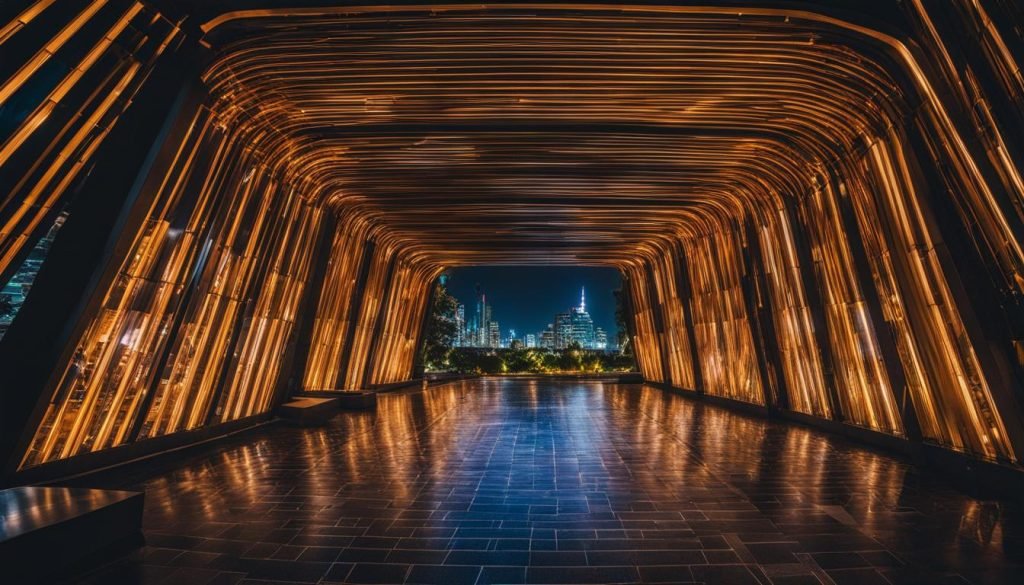
Lastly, practice is paramount. Dedicate regular time to photographing buildings, whether it’s in your local area or during your travels. Make use of different weather conditions and lighting situations to add variety and depth to your photographs. Embrace the magic of golden hours or explore the enchantment of night photography to capture buildings in different moods and atmospheres.
With a commitment to continuous improvement, attending workshops, engaging with the photography community, experimenting with different approaches, and regular practice, you can refine your architecture photography skills and create stunning images that capture the essence of buildings.
Conclusion
Architecture photography is a captivating art form that requires a blend of technical skills and artistic vision. By understanding the equipment, mastering composition techniques, and harnessing the power of light, photographers can capture stunning images of architectural structures. It’s a field that offers endless possibilities for exploration and expression, and with dedication and practice, you can become a skilled architectural photographer capable of showcasing the beauty and character of buildings in the UK and beyond.
Whether you’re capturing historic landmarks or contemporary architectural marvels, the UK provides a wealth of subjects to explore. By embarking on photography tours, visiting different cities and regions, and expanding your portfolio, you can discover unique architectural gems and add depth to your body of work.
As you continue your journey in architecture photography, it’s essential to continuously improve your skills. Attend workshops, join photography communities, and engage with other architectural photographers to gain insights and learn new techniques. Experiment with different styles and approaches to develop your own artistic vision. By practicing regularly and challenging yourself with new projects, you can refine your ability to capture the essence of buildings and create impactful images that showcase their beauty and character.
FAQ
What is architecture photography?
Architecture photography is a specialized genre that focuses on capturing buildings and structures in a visually appealing way.
What equipment do I need for architecture photography?
To achieve the best results in architecture photography, it’s essential to have a high-quality camera with wide-angle lenses, a tripod for stability, a remote shutter release for long exposures, a lens hood to minimize lens flare, and a polarizing filter to control reflections.
What composition techniques are commonly used in architecture photography?
Leading lines, symmetry, framing, and the rule of thirds are commonly used composition techniques in architecture photography.
How does lighting affect architecture photography?
Lighting plays a crucial role in architecture photography as it can greatly influence the overall mood and appearance of a building. Shooting during the golden hours, shortly after sunrise or before sunset, and using long exposure techniques at night can create stunning architectural images.
How can I enhance my architecture photographs through editing?
Editing software like Adobe Lightroom or Photoshop can be used to enhance colors, contrast, and sharpness of architecture photographs. Adjustments to perspective correction, white balance, and removing distractions can also be made during the editing process.
How can I showcase my architecture photography portfolio?
Building a strong architecture photography portfolio is crucial for showcasing your skills. Consider creating an online portfolio, participating in exhibitions and competitions, and networking within the industry.
Where can I explore architecture photography in the UK?
The United Kingdom offers a wealth of architectural wonders to explore and capture through photography. From historic landmarks like Buckingham Palace to contemporary marvels like the Shard, there’s no shortage of subjects to photograph in the UK.
What tips can you give for beginners in architecture photography?
Study the work of renowned architectural photographers, experiment with different angles and perspectives, and practice regularly to improve your skills in architecture photography.
How can I enhance my architecture photography skills?
Attend workshops, join photography communities, and engage with other architectural photographers to gain insights and learn new techniques. Experiment with different styles and approaches, and challenge yourself with new projects to refine your ability to capture the essence of buildings.





